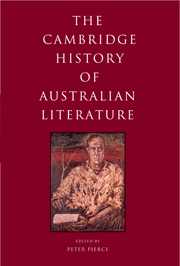Book contents
- Frontmatter
- Introduction
- FROM EUROPEAN IMAGININGS OF AUSTRALIA TO THE END OF THE COLONIAL PERIOD
- FROM THE LATE NINETEENTH CENTURY TO 1950
- TRAVERSES
- FROM 1950 TO NEARLY NOW
- 17 Publishing, patronage and cultural politics: Institutional changes in the field of Australian literature from 1950
- 18 Theatre from 1950
- 19 The short story since 1950
- 20 Scribbling on the fringes: Post-1950 Australian poetry
- 21 Groups and mavericks
- 22 The challenge of the novel: Australian fiction since 1950
- 23 The novel, the implicated reader and Australian literary cultures, 1950–2008
- 24 Nation, literature, location
- Select bibliography
- Index
- References
19 - The short story since 1950
from FROM 1950 TO NEARLY NOW
Published online by Cambridge University Press: 28 May 2011
- Frontmatter
- Introduction
- FROM EUROPEAN IMAGININGS OF AUSTRALIA TO THE END OF THE COLONIAL PERIOD
- FROM THE LATE NINETEENTH CENTURY TO 1950
- TRAVERSES
- FROM 1950 TO NEARLY NOW
- 17 Publishing, patronage and cultural politics: Institutional changes in the field of Australian literature from 1950
- 18 Theatre from 1950
- 19 The short story since 1950
- 20 Scribbling on the fringes: Post-1950 Australian poetry
- 21 Groups and mavericks
- 22 The challenge of the novel: Australian fiction since 1950
- 23 The novel, the implicated reader and Australian literary cultures, 1950–2008
- 24 Nation, literature, location
- Select bibliography
- Index
- References
Summary
The ancient storyteller needed an audience and an occasion to perform a story; similarly, the modern short story must find a textual host and reader. By and large, a short story’s textual history begins with publication in a periodical. There are other possibilities – competitions, readings (live or on the radio or television), even internet publication – but overwhelmingly the printed newspaper, magazine or journal is the first option. After that, republication in book form is possible, whether in anthology, miscellany or single-author collection. From the beginning, a short story’s textual life is bound up with the practical, financial, ideological and editorial complexities of the publishing world, and this account of the Australian short story in the last half of the 20th century begins there.
Periodicals, anthologies, and short story publication
In Australia, the period immediately after World War II focused on Australian patriotism, economic recovery, immigration, sport, family values and suburban expansion. Literary endeavour was not high on the list. Yet compared to the limited options for publishing short stories overseas, the Australian market was encouraging. Major capital city newspapers accepted them, and the Bulletin continued its seminal role in short story advocacy. A range of popular magazines took short stories, not just women’s magazines that favoured romance, but those based on professional or trade interests, or with political or social agendas. Principally, though, it was the establishment of the literary periodicals that most influenced the range and quality of work in the short story mode: Southerly first appeared in 1939, Meanjin in 1940, Overland in 1954, Quadrant and Westerly in 1956, and Realist Writer in 1958.
- Type
- Chapter
- Information
- The Cambridge History of Australian Literature , pp. 419 - 451Publisher: Cambridge University PressPrint publication year: 2009

